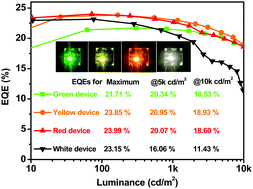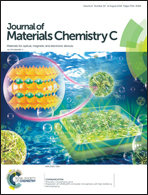Precise manipulation of the carrier recombination zone: a universal novel device structure for highly efficient monochrome and white phosphorescent organic light-emitting diodes with extremely small efficiency roll-off†
Abstract
Achieving superior device efficiency and very small efficiency roll-off simultaneously for all phosphorescent OLEDs (PHOLEDs) is still an open challenge. In this work, a universal novel device structure, having mixed hosts sandwiched between hole- and electron-transporting hosts, was proposed, and a series of monochrome and white PHOLEDs based on the proposed novel device structure were developed. All the resulting PHOLEDs achieve a maximum external quantum efficiency (EQE) exceeding the theoretical limit, reaching 21.71%, 23.85%, 23.99%, 21.79%, and 23.15% for green, yellow, red, blue, and white PHOLEDs, respectively. Moreover, apart from blue PHOLEDs using inefficient blue phosphor, other monochrome and white PHOLEDs show extremely small efficiency roll-off. At a practical luminance of 5000 cd m−2, the EQE is still up to 20.34%, 20.95%, 20.07%, and 16.06% for green, yellow, red, and white PHOLEDs, respectively. Such high device performance is testified from the precise manipulation of the carrier recombination zone via a novel device structure, which contributes to a strictly limited and broadened carrier recombination zone, a balanced distribution of electrons and holes, as well as consequentially reduced triplet exciton aggregation and polaron formation, thus effectively boosting the device efficiency and suppressing the notorious triplet–triplet annihilation and triplet–polaron quenching.



 Please wait while we load your content...
Please wait while we load your content...